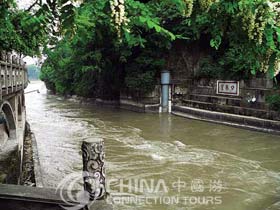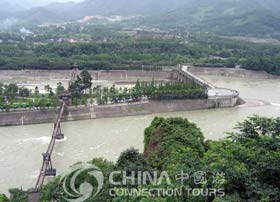
 The Dujiangyan Irrigation system is a miracle in the water works construction of ancient China. Built over 2,200 years ago, it still provides benefits for the people. The irrigation system was erected on the Minjiang River at the foot of Yulei Mountain, northwest of Dujiangyan City in Sichuan Province. Here the Minjiang River, after being joined by many tributaries in its upper reaches, runs toward the Chengdu Plain. As the Yulei Mountain originally blocked the river so that water could not flow eastward, the plain had no access to river irrigation and agricultural development in the region was therefore seriously affected. Li Bing, governor of Shu Prefecture during the Warring States period (475-221 BC), made a careful survey of the region and then had a channel cut through Yulei Mountain. He put a dyke in the middle of the Minjiang River to divide it into two parts. This happened about 250 BC. He also ordered the local people to open channels and canals on the plain so as to divert the river for irrigation purposes. This finally tamed the Min River and irrigated the surrounding plains.
The Dujiangyan Irrigation system is a miracle in the water works construction of ancient China. Built over 2,200 years ago, it still provides benefits for the people. The irrigation system was erected on the Minjiang River at the foot of Yulei Mountain, northwest of Dujiangyan City in Sichuan Province. Here the Minjiang River, after being joined by many tributaries in its upper reaches, runs toward the Chengdu Plain. As the Yulei Mountain originally blocked the river so that water could not flow eastward, the plain had no access to river irrigation and agricultural development in the region was therefore seriously affected. Li Bing, governor of Shu Prefecture during the Warring States period (475-221 BC), made a careful survey of the region and then had a channel cut through Yulei Mountain. He put a dyke in the middle of the Minjiang River to divide it into two parts. This happened about 250 BC. He also ordered the local people to open channels and canals on the plain so as to divert the river for irrigation purposes. This finally tamed the Min River and irrigated the surrounding plains.
The ancient Dujiangyan Irrigation System is unique and a scientific marvel. It provides the vital passage that joins mountain and plain. The main system consists of three parts: a fish-mouth-like water-dividing dyke, two spillways for discharging flood waters and  silt, and a channel cut through Yulei Mountain as a water inlet. These three parts interact and depend on one another, constituting a carefully designed and reasonably arranged water diversion hub that contributes to irrigation, flood control, and shipping.
silt, and a channel cut through Yulei Mountain as a water inlet. These three parts interact and depend on one another, constituting a carefully designed and reasonably arranged water diversion hub that contributes to irrigation, flood control, and shipping.
The Dujiangyan Region has a beautiful landscape and many cultural relics and historical sites, including the Fulong Temple, Erwang Temple, and the trail bridge. All of these, plus moving legends have exerted a great attraction for both domestic and overseas tourists.
The tourist site of the Dujiangyan Irrigation System was listed by the United Nations Heritage Commission as one of the World's Cultural Heritage on November 29, 2000.

